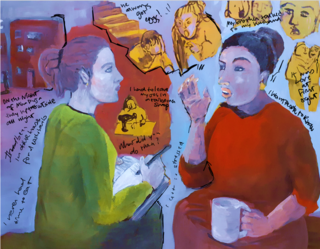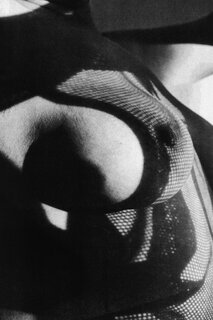
This work belongs to a collection of paintings telling the story of Maya, one of my key informants in my ethnographic research in Nepal (2018-2019). Following domestic mistreatment in the joint family, Maya experienced a mental health crisis leading to accusations of ghost possession. Her struggle continued until when she underwent a ritual of exorcism, which opened her eyes on the need to change her destiny and to escape from that situation together with her husband. In this painting, Maya has their hands tied and is beaten with a stick. I have framed the brutality of this ritual with some key words and phrases, such as “remember to escape” and I have digitally added a poem extracted from The Yuddha Varjit Sahar (The Town where War Was Banned) by Nepali poet Mohan Koirala.
The poem reads:
How far away has the border been fixed
That may not be touched by the fingers of dreams?
Where is the district that imaginings may not reach?
Where might one go in one’s thoughts, and where not?
While Maya’s story has a happy ending, too many people in Nepal are still facing mental issues that remain untreated due to lack of information and social stigma. An integration of painting within social anthropology can provide a useful tool not only for the researcher to better understand the emotional nuances of ethnography, but also to the viewer, who can be brought closer to the subjects and to their experiences, and ultimately sensitized to these issues. With my artworks I hope to provide a contribution in this direction of research, by portraying the making of individual selves in a changing society facing a redefinition of socially acceptable behaviours and the boundaries between right and wrong. Ultimately, in answering the question of this exhibition, ‘what is an image?’ by reflecting on this painting, I would answer that an image such as this is a space of confrontation and change. By containing Maya’s own presence, my comments, and the voice of a local poet, this canvas reveals the nature of the anthropological encounter as a collaborative work, a creative process in which the researcher and the subject act together to write a story with multiple points of view.
REFERENCES
Hutt, M 2012, Eloquent hills: Essays on Nepali literature, Martin Chautari, Kathmandu.
ARTIST BIOGRAPHY
Paola Tiné is an anthropologist and artist based at the University of Adelaide (South Australia). Her recent research has involved in-depth data collection over 15-months with over 100 participants in Nepal, to investigate an ongoing process of social change. The focus of this study is on domestic transformations and how these are influenced by and contributing to a local ethos among middle-class families in the Newar town of Bhaktapur. Over the last ten years she has been writing on the topic of the use of visual methodologies in anthropological research as a form of analysis and expression, publishing in peer-reviewed journals such as Current Anthropology, and in edited books by Bloomsbury Academics.





